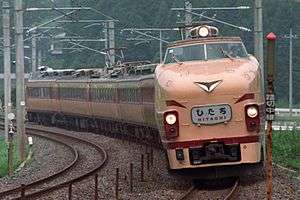207 series (JR East)
The 207 series (207系) or 207-900 series (207系900番台) was a commuter electric multiple unit (EMU) train type introduced in 1986 by Japanese National Railways (JNR) and operated by East Japan Railway Company (JR East) on through services between the Joban Line and Tokyo Metro Chiyoda Line.[2] Only one 10-car set was built, which was withdrawn in December 2009.
| 207 series | |
|---|---|
 The 207 series set at Matsudo Station in May 2006 | |
| In service | November 1986 – December 2009 |
| Manufacturer | Kawasaki Heavy Industries, Tokyu Car Corporation |
| Constructed | 1986 |
| Scrapped | January 2010 |
| Number built | 10 vehicles (1 set) |
| Number in service | None |
| Number preserved | None |
| Number scrapped | 10 vehicles |
| Successor | E233-2000 series |
| Formation | 10 cars per trainset |
| Fleet numbers | 71 |
| Operator(s) | JNR (1986–1987) JR East (1987–2009) |
| Depot(s) | Matsudo |
| Line(s) served | Joban Line, Tokyo Metro Chiyoda Line |
| Specifications | |
| Car body construction | Stainless steel |
| Car length | 19,500 mm (64 ft 0 in) |
| Width | 2,800 mm (9 ft 2 in) |
| Height | 4,140 mm (13 ft 7 in) |
| Doors | 4 pairs per side |
| Maximum speed | 80 km/h (50 mph) (Chiyoda Line) 90 km/h (56 mph) (Jōban Line) 100 km/h (60 mph) (Design) |
| Weight | 299.9 t per set |
| Traction system | GTO-VVVF |
| Power output | 3,600 kW |
| Acceleration | 3.3 km/h/s |
| Deceleration | 5.0 km.h/s (emergency) |
| Electric system(s) | 1,500 V DC overhead catenary |
| Current collection method | PS21 lozenge-type pantograph[1] |
| Bogies | DT50E (motored) TR235F (trailer) |
| Safety system(s) | ATS-SN, New CS-ATC |
| Track gauge | 1,067 mm (3 ft 6 in) |
Design
Based on the earlier 205 series design, the 207-900 series was a prototype built as the first VVVF-controlled EMU operated by JNR.[2] The 207 series built later by JR West bears no relation to this train.[3]
The train used adjustable voltage/adjustable frequency (AVAF) inverters and induction motors using gate turn-off thyristor (GTO) components.[4]
Formation
The sole 10-car set, numbered "71", was formed as follows, with car 1 at the Yoyogi-Uehara end and car 10 at the Toride end.[1]
| Car No. | 1 | 2 | 3 | 4 | 5 | 6 | 7 | 8 | 9 | 10 |
|---|---|---|---|---|---|---|---|---|---|---|
| Designation | T'c | M2 | M1 | T2 | M2 | M1 | T1 | M2 | M1 | Tc |
| Numbering | KuHa 206-901 | MoHa 206-903 | MoHa 207-903 | SaHa 207-902 | MoHa 206-902 | MoHa 207-902 | Saha 207-901 | MoHa 206-901 | MoHa 207-901 | KuHa 207-901 |
Cars 3, 6, and 9 were each fitted with one PS21 lozenge-type pantograph.[1]
Interior
- Interior of a 207-900 series car in September 2007
History
The train was delivered to Matsudo Depot in November 1986.[3]
It was withdrawn from service in 2009 following the introduction of new E233-2000 series EMUs, and a final "Sayonara" service was run on 5 December 2009.[5] The train was transferred to Nagano on 5 January 2010 for scrapping.[6]
References
- JR電車編成表 '07冬号 [JR EMU Formations - Winter 2007]. Japan: JRR. December 2006. p. 72. ISBN 978-4-88283-046-7.
- JR全車輌ハンドブック2006 [JR Rolling Stock Handbook 2006]. Japan: Neko Publishing. 2006. p. 347. ISBN 978-4-7770-0453-9.
- プロトタイプの世界 - Prototype World. Japan: Kōtsū Shimbunsha. December 2005. pp. 92–93. OCLC 170056962.
- YAMAMOTO, Takamitsu (2017). "Trends and Recent Studies on Hybrid Railway Vehicles". Quarterly Report of RTRI. 58: 1–5. doi:10.2219/rtriqr.58.1_1.
- 来月5日に常磐線「207系」のさよなら運転 [Joban Line 207 series final run on 5 December]. MSN News (in Japanese). Japan: The Sankei Shimbun & Sankei Digital. 18 November 2009. Archived from the original on 22 November 2009. Retrieved 25 October 2011.
- 207系900番台が長野総合車両センターへ [207-900 series sent to Nagano Works]. Japan Railfan Magazine Online (in Japanese). Japan: Koyusha Co., Ltd. 6 January 2010. Archived from the original on 13 January 2010. Retrieved 25 October 2011.
External links
| Wikimedia Commons has media related to JNR 207. |
"JR East 207 series". jreast.co.jp. Archived from the original on 10 February 2010. Retrieved 2009-03-19.
